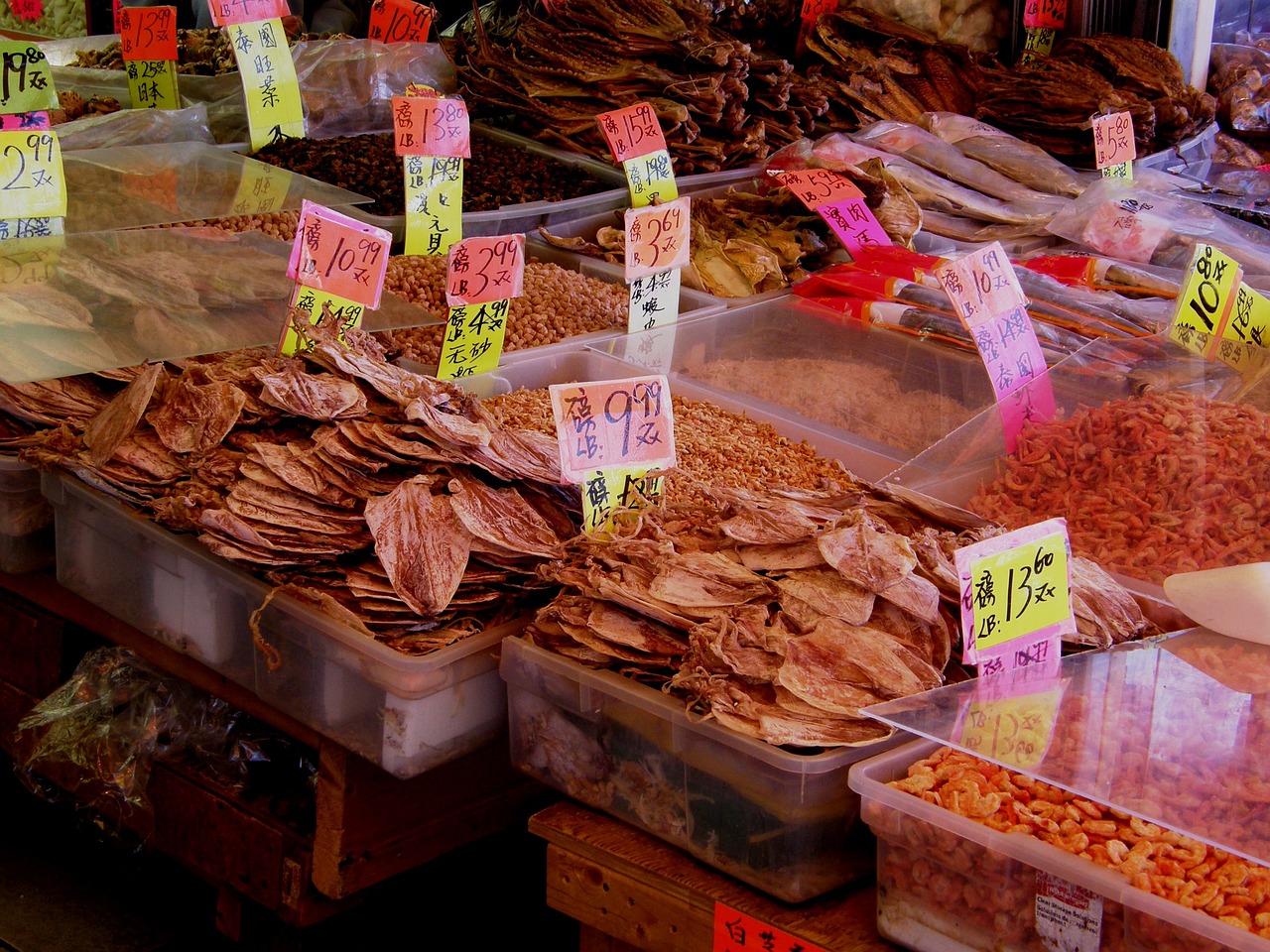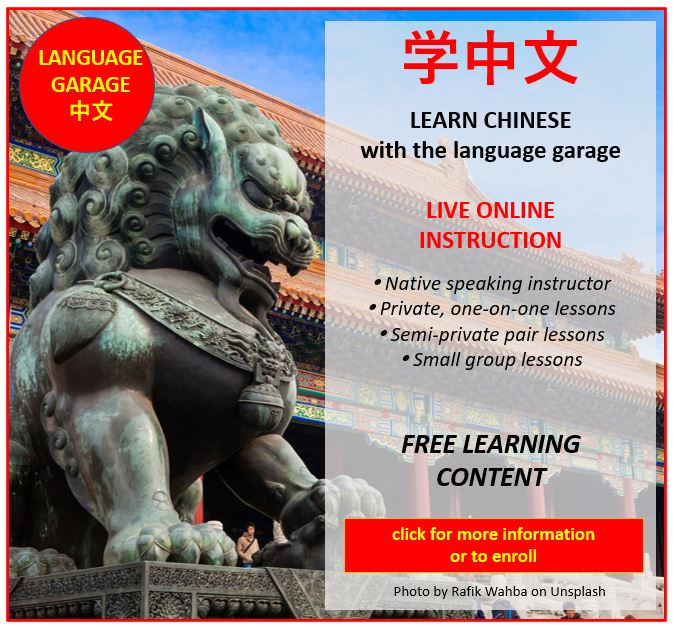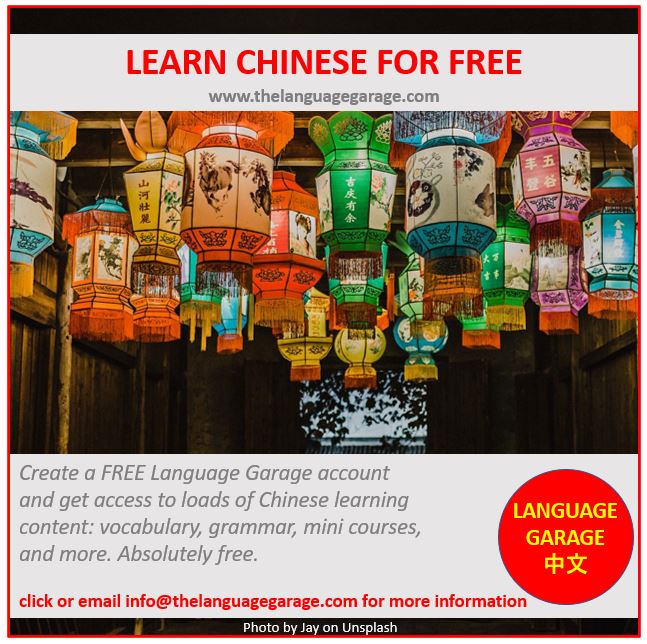食物 shíwù: Basic Chinese Food Vocabulary
In this post we’ll build your Chinese vocabulary by learning about everyone’s favorite language topic: Chinese food terms! Chinese food vocabulary will come in handy no matter why you’re learning Chinese, so let’s dig in.
我饿了!Wǒ è le! I’m hungry!
Let’s start to build your Chinese vocabulary by learning some expressions that you’ll probably need to know when you use Chinese food vocabulary.
- 我饿了!
Wǒ è le!
I’m hungry. - 我渴了!
Wǒ kě le!
I’m thirsty.
- 我想吃东西。
Wǒ xiǎng chī dōngxī.
I want something to eat. - 我想喝东西。
Wǒ xiǎng hē dōngxī.
I want something to drink. - 我想吃点心。
Wǒ xiǎng chī diǎnxīn.
I feel like a snack.
晚餐好了!Wǎncān hǎo le! Dinner is ready!
You probably want to know how to talk about meals when you’re using Chinese food terms. The meals in Chinese are 早餐 zǎocān (breakfast), 午餐 wǔcān (lunch), and 晚餐 wǎncān (dinner). A snack is 点心 diǎnxīn. Dessert is 点心 diǎnxīn. Let’s put that Chinese vocabulary to work in some practical examples.
- 早餐吃什么?
Zǎocān chī shénme?
What’s for breakfast? - 午餐吃什么?
Wǔcān chī shénme?
What’s for lunch? - 晚餐吃什么?
Wǎncān chī shénme?
What’s for dinner? - 点心吃什么?
Diǎnxīn chī shénme?
What’s for dessert? - 我吃早餐吃得早。
Wǒ chī zǎocān chī de zǎo.
I eat breakfast early. - 我和同事吃午餐。
Wǒ hé tóngshì chī wǔcān.
I eat lunch with colleagues. - 我和家人吃晚餐。
Wǒ hé jiārén chī wǎncān.
I eat dinner with my family.
你在吃什么? Nǐ zài chī shén me ? What are you eating?
Now let’s see some basic Chinese vocabulary related to foods and beverages. We’ll divide these Chinese food terms into sections.
- 面包 miànbāo bread
- 饭 fàn rice
- 意大利面 yìdàlì miàn pasta
- 面条 miàntiáo noodles
- 肉 ròu meat
- 鸡肉 jīròu chicken
- 牛肉 niúròu beef
- 猪肉 zhūròu pork
- 火腿 huǒtuǐ ham
- 羊肉 yángròu lamb
- 鱼 yú fish
- 海鲜 hǎixiān seafood
- 虾 xiā shrimp, prawn
- 螃蟹 pángxiè crab
- 龙虾 lóngxiā lobster
- 蛤 há clam
- 蚌 bàng mussel
- 扇贝 shànbèi scallop
- 乌贼 wūzéi squid
- 豆腐 dòufu tofu
- 蔬菜 shūcài vegetables
- 番茄 fānqié tomato
- 洋葱 yángcōng onion
- 大蒜 dàsuàn garlic
- 莴苣 wōjùl ettuce
- 菠菜 bōcài spinach
- 芦笋 lúsǔn asparagus
- 卷心菜 juǎnxīncài cabbage
- 蘑菇 mógū mushroom
- 黄瓜 huángguāc ucumber
- 青椒 qīngjiāo pepper (as in bell)
- 辣椒 làjiāo chili pepper
- 水果 shuǐguǒ fruit
- 苹果 píngguǒ apple
- 梨子 lízi pear
- 桃子 táozi peach
- 橙 chéng orange
- 柠檬 níngméng lemon
- 葡萄 pútáo grape
- 草莓 cǎoméi strawberry
- 香蕉 xiāngjiāo banana
- 坚果 jiānguǒ nut
- 花生 huāshēng peanut
- 种子 zhǒngzǐ seed
- 小麦 xiǎomài wheat
- 麦片 màipiàn cereal
- 盐 yán salt
- 胡椒 hújiāo pepper
- 芝麻 zhīma sesame
- 蜂蜜 fēngmì honey
- 糖 táng sugar
- 酱油 jiàngyóu soy sauce
- 蛋 dàn egg
- 牛奶 niúnǎi milk
- 起司 qǐsī cheese
- 黄油 huángyóu butter
- 水 shuǐ water
- 茶 chá tea
- 咖啡 kāfēi coffee
- 酒jiǔ wine
- 啤酒 píjiǔ beer
- 豆浆 dòujiāng soy milk
- 果汁 guǒzhī juice
- 冰淇淋 bīngqílín ice cream
- 蛋糕 dàngāo cake
- 派 pài pie
- 曲奇饼 qū qí bǐngcookie
- 糖果 tángguǒ candy
- 吃 chī to eat
- 喝 hē to drink
- 做饭 zuò fàn to cook
- 尝 cháng to taste
- 我吃了很多米饭。
Wǒ chīle hěnduō mǐfàn.
I eat a lot of rice. - 你早上喝茶还是咖啡?
Nǐ zǎoshang hē chá háishì kāfēi?
Do you drink tea or coffee in the morning? - 你做饭很好吃!
Nǐ zuò fàn hěn hào chī!
You cook very well!
可以给我一杯水吗? Kěyǐ gěi wǒ yìbēi shuǐ ma? Could I have a glass of water?
Now that you know some basic Chinese food vocabulary, let’s see some phrases that will come in handy when you’re ordering food. Some vocabulary related to Chinese food terms is: 盘子 pánzi plate, 碗 wǎn bowl, 刀 dāo knife, 汤匙 tāngchí spoon, 叉子 chāzi fork, 筷子 kuàizi chopsticks, 杯子 bēizi cup, 玻璃杯 bōlí bēi glass, 餐巾纸 cānjīnzhǐ napkin.
- 可以给我 餐巾纸/叉子/刀子/汤匙/筷子 吗?
Kěyǐ gěi wǒ cānjīnzhǐ / chāzi / dāozi / tāngshi / kuàizi ma?
Could I have a napkin/fork/knife/spoon/chopsticks? - 可以给我一杯水吗?
Kěyǐ gěi wǒ yìbēi shuǐ ma?
Could I have a glass of water? - 叉子、刀子和汤匙在哪里?
Chāzi, dāozi hé tāngchí zài nǎlǐ?
Where are the forks, knives, and spoons? - 叉子、刀子和汤匙都在抽屉里。
Chāzi, dāozi hé tāngchí dōu zài chōutì lǐ.
The forks, knives, and spoons are in the drawer. - 干净的玻璃杯在柜子里。
Gānjìng de bōlí bēi zài guìzi lǐ.
The clean glasses are in the cabinet. - 咖啡杯在架子上。
Kāfēi bēi zài jiàzi shàng.
The coffee cups are on the shelf. - 请给我一张餐巾纸好吗?
Qǐng gěi wǒ yī zhāng cānjīnzhǐ hǎo ma?
Could I have a napkin, please? - 请把干净的盘子放在柜子里。
Qǐng bǎ gānjìng de pánzi fàng zài guìzi lǐ.
Please put the clean plates in the cabinet.
你的菜怎么样?Nǐ de cài zěnmeyàng? How’s your food?
Let’s close with some Chinese vocabulary that you can use to talk about your food: 好吃 hào chī delicious, 咸的 xián de salty, 甜的 tián de sweet, 苦的 kǔ de bitter, 酸的 suān de sour.
- 很好吃。
Hěn hǎo chī.
It’s delicious. - 很棒。
Hěn bàng.
It’s great. - 菜非常美味。
Cài fēi cháng měi wèi.
This food is excellent. - 太辣了。
Tài là le.
It’s too hot (spicy). - 太烫了。
Tài tàng le.
It’s too hot (temperature). - 太冷了。
Tài lěng le.
It’s too cold. - 太甜了。
Tài tián le.
It’s too sweet. - 太咸了。
Tài xián le.
It’s too salty. - 没有味道。
Méi yǒu wèi dào.
It’s tasteless/bland. - 煮太久了。
Zhǔ tài jiǔ le.
It’s overcooked. - 没煮熟。
Méi zhǔ shú.
It’s undercooked. - 太油了。
Tài yóu le.
It’s oily/greasy.
Do you want to learn Chinese?
We hope you’ve enjoyed growing your Chinese vocabulary by learning Chinese food terms. Check out our other posts on Chinese language, culture, and more. And if you’re looking for convenient and affordable live Chinese lessons with a real teacher, check out The Language Garage. Our lessons are given online in a virtual classroom, so it doesn’t matter where you live or work – we can come to you. And we have flexible options, with a free trial so that you can decide if there’s a fit. Check us out!
Image by Neale Bacon from Pixabay






